ShenZhen WFLY Technology Development WFT09II RADIO CONTROL SYSTEM User Manual
Shen Zhen WFLY Technology Development Co., Ltd. RADIO CONTROL SYSTEM Users Manual
Contents
- 1. USERS MANUAL 1
- 2. USERS MANUAL 2
- 3. USERS MANUAL 3
- 4. USERS MANUAL 4
USERS MANUAL 4
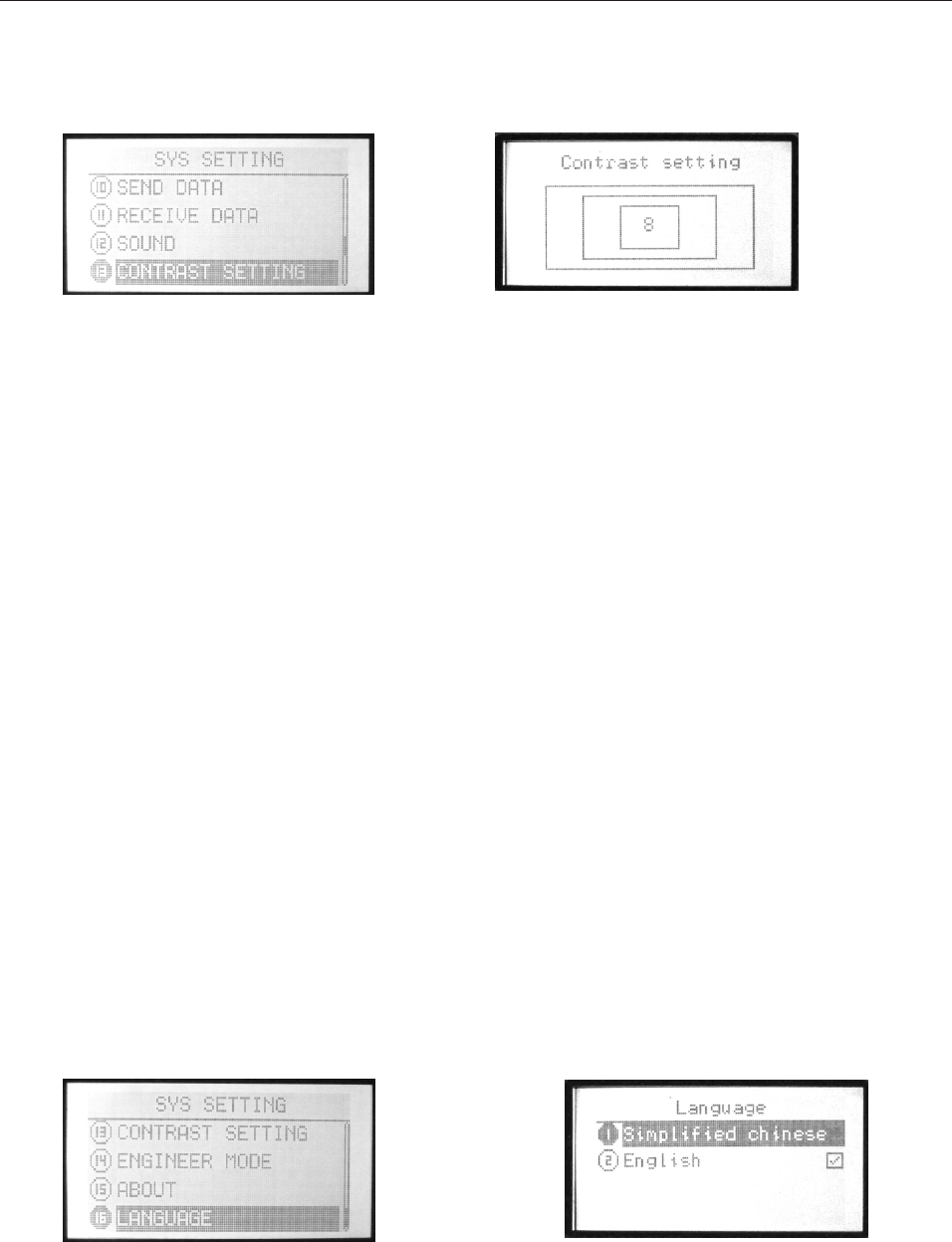
This function is to adjust the LCD brightness by increasing
or decreasing the contrast value.
Setting Method:
Press Menu and turn on the transmitter to enter “SYS SETTING”
Use up/down button to select “RECEIVE DATA”, OK button is
to enter editing.
Steps:
1. Use +/- button to increase or decrease the value.
2. Press OK button for a while is to back default.
3. Press EXIT after setting.
14.CONTRAST SETTING
16.LANGUAGE
This function is to select the language. The selection is
as shown in the picture,if only English or Chinese menu,
the function is not exist.
INSTRUCTION
GLIDER
131
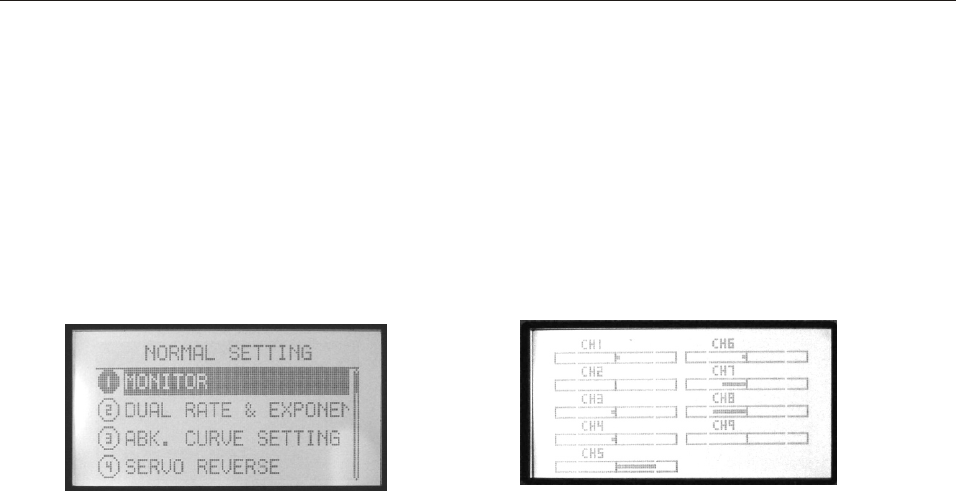
NORMAL SETTING(AIRPLANE)
1. MONITOR
Monitor shows the servos’ movement situation.
In PCMS, this function is to describe the 9 channels output.
In PPM, this function is to describe the first 8 channels output.
Setting Method:
Press menu button, enter system setting, the first function is
the monitor.
INSTRUCTION
GLIDER
132
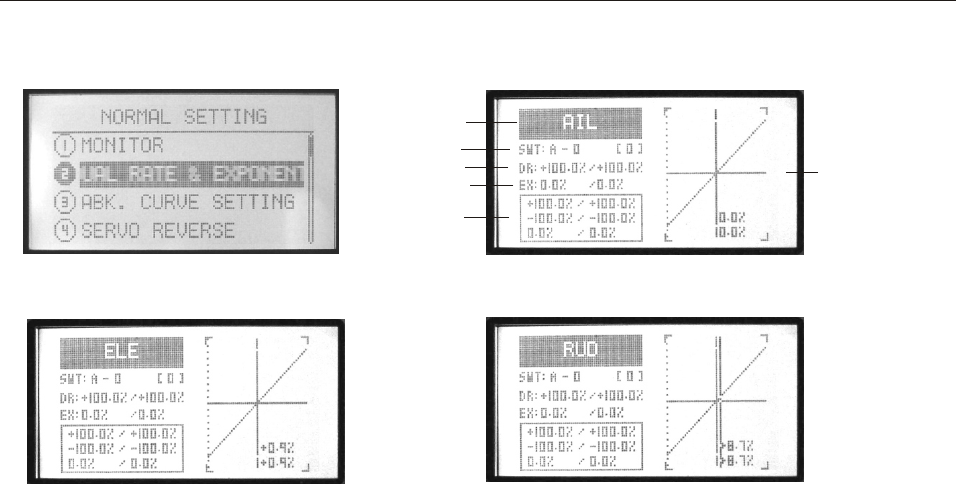
2. DUAL RATE & EXPONENTIAL SETTING
(1). AIL
(2). ELE (3). RUD
Dual rate is to adjust aileron, elevator and rudder travel range.
The range is between 0%-120%.
Exponential setting is to adjust aileron, elevator and rudder
sensitivity when the sticks are around the middle. The range is
between -100% to +100%.
Setting Method:
1. Select channel
Aileron, elevator and rudder are selectable. Press +/- buttons
to select channel, OK button to finish setting.
2. Set the switch and its position(0,1,2)
Press direction button to select “SWT”, edit it. +/- buttons can
select function switch(A-F).
After selecting the function switch, press right direction button
to enter the switch position setting, use +/- buttons to set.
3. Set dual rate
Press direction button to select “D/R”, edit it. Edit one or two
parameter.
+/- buttons can increase or decrease the value.
Press the OK button is to back default.
4. Set exponential
Press direction button to select “EX”. Exponential can adjust
aileron, throttle and rudder sensitivity as the stick at the middle.
5. Set curve point (normal/advanced)
The box under “EX” shows the curve points.
Select “Curve setting” in More setting function list.
Please refer to Page 27 for detail curve setting.
6. Press EXIT after all the values are finished setting.
Servo
Switch
Dual rate
Exponential
Curve point
Curve picture
(please refer to Page 27)
INSTRUCTION
GLIDER
133
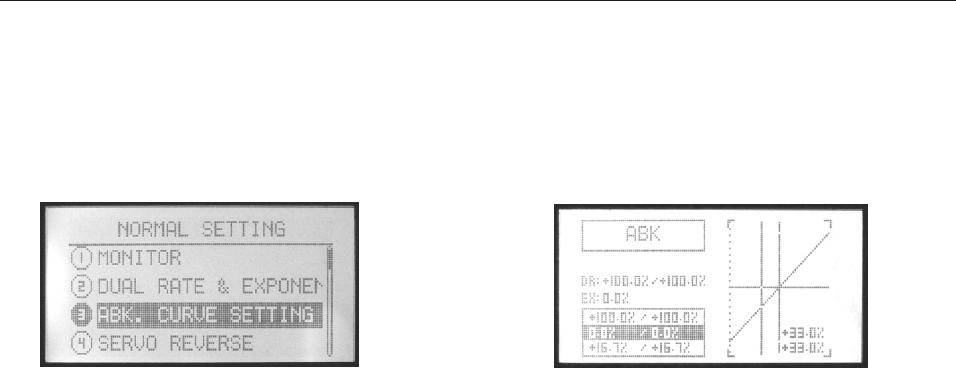
3. ABK. CURVE SETTING
This function is used to make the glider speed down.
Setting Method:
Use up/down button to select ABK. CURVE SETTING, OK button is to
enter editing.
Steps:
1. Use direction buttons to select editing part.
2. Use +/- button or OK button to switch the servo movement
direction.
3. Press EXIT after setting.
INSTRUCTION
GLIDER
134
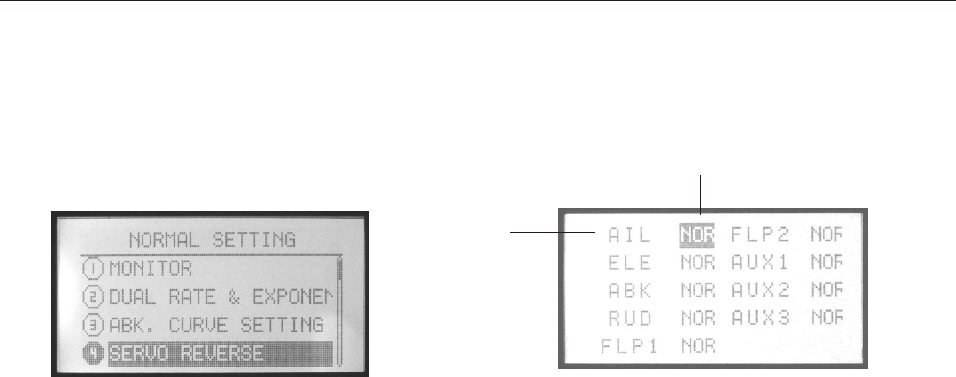
4. SERVO REVERSE
This function is to change the direction of the servos movement.
Setting Method:
Use up/down button to select SERVO REVERSE, OK button is to
enter editing.
Steps:
1. Use direction buttons to select editing part.
2. Use +/- button or OK button to switch the servo movement
direction.
3. Press EXIT after setting.
Direction (Rev-reverse, Nor-normal)
Channel
INSTRUCTION
GLIDER
135
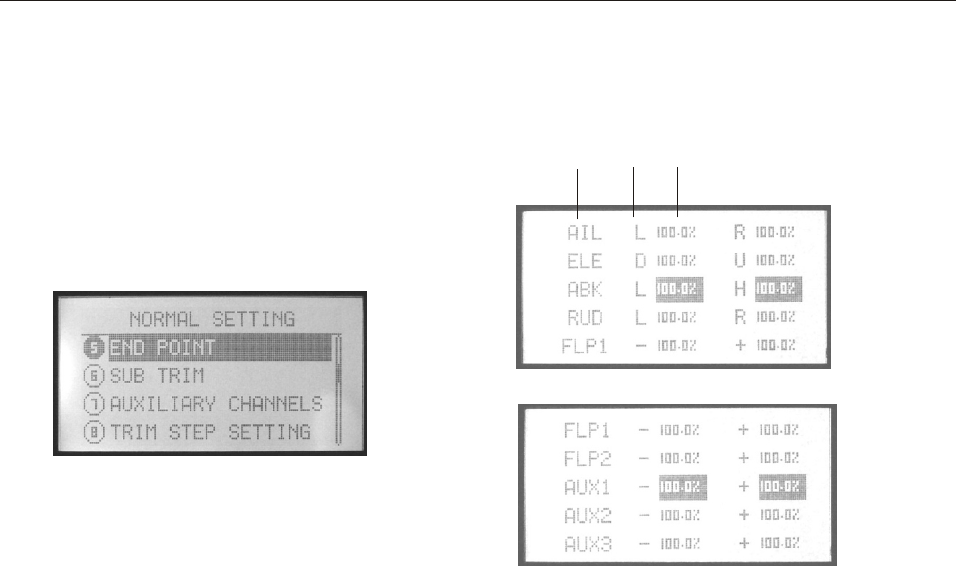
5. END POINT
It is to adjust the end of individual servo’s travel. The range is
from 0% to 120%.
Setting Method:
Use up or down button to select END POINT, OK button is to
enter editing.
Steps:
1. Use direction buttons to select editing part.
2. Use +/- button or OK button to set the travel value. Press
OK for a while backs to default.
3. Press EXIT after setting.
Channel Side Value
INSTRUCTION
GLIDER
136
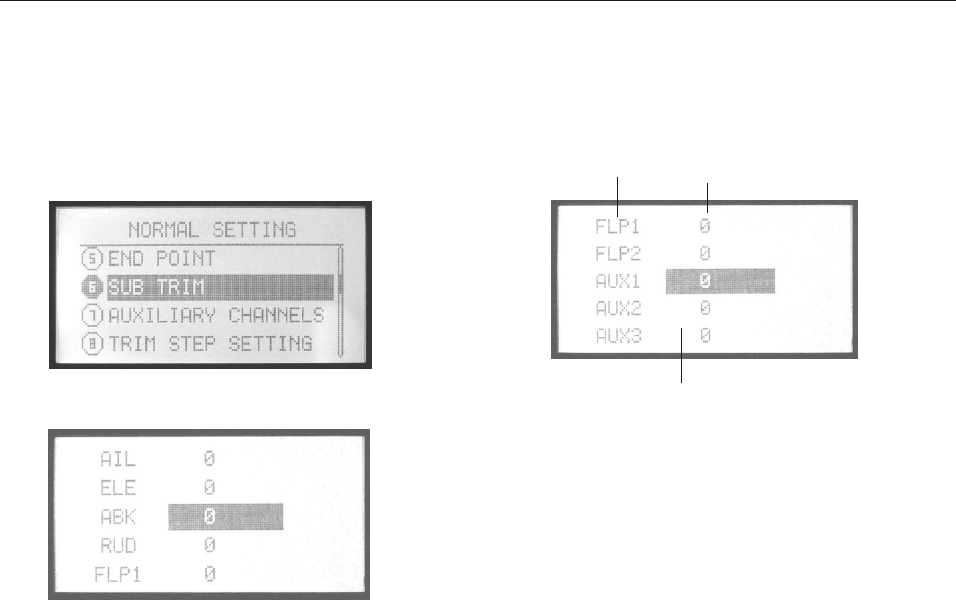
6. SUB TRIM
Sub trim makes small changes or corrections to the neutral
position of each servo. Range is -120 to +120, default setting
is 0.
Setting Method:
Use up or down button to select SUB TRIM, OK button is to
enter editing.
Steps:
1. Use direction buttons to select editing part.
2. Use +/- button or OK button to set the trim value. Press OK
for a while backs to default.
3. Press EXIT after setting.
We recommend that you center the digital trims before making
Sub trim changes, and that you tryto keep all of the Sub trim
values as small as possible. Otherwise, when the Sub trims
are large values, the servo’s range of travel is restricted on
one side.
Channel Value
High/Low
INSTRUCTION
GLIDER
137
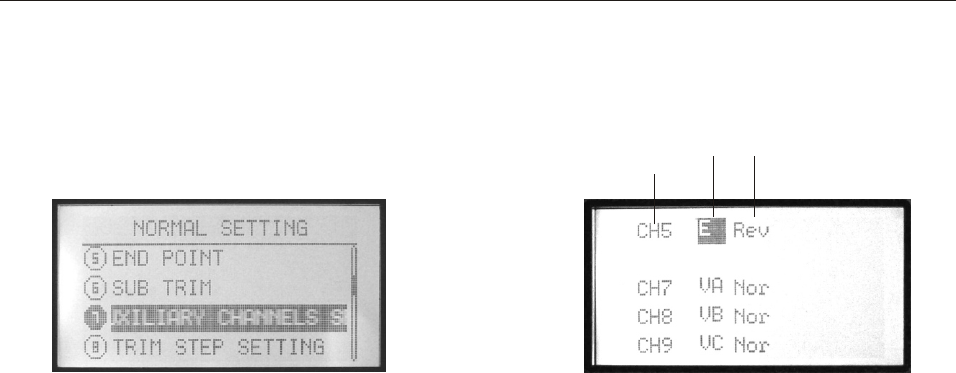
7. AUXILIARY CHANNELS SETTING
This function is for channel 5 to channel 9 function setting.
Setting Method:
Use up or down button to select AUXILIARY CHANNELS
SETTING, OK button is to enter editing.
Steps:
1. Use direction buttons to select editing part.
2. Use +/- button to set the switches or knobs. The switches can
be set from A to F, the knobs can be set as VA, VB, VC, VL,
VR or none(-).
3. Use left or right direction button to set normal or reverse
direction of every channel.
4. Press EXIT after setting.
Channel Switch Direction
INSTRUCTION
GLIDER
138
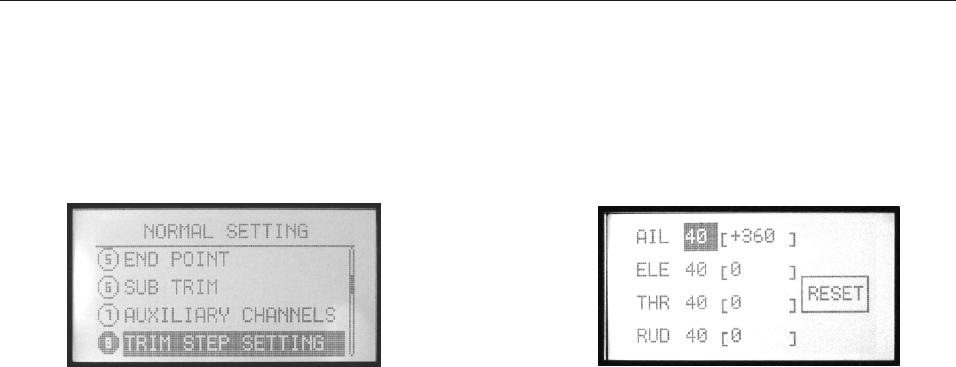
8. TRIM STEP SETTING
This function is to change the rate at which the trim moves
when the TRIM LEVER is activated. The range is from 1to
250. Generally larger trim steps are for models with larger
control throws or for first flights to ensure sufficient trim to
properly correct the model. Smaller trim steps are later used
to allow very fine adjustments in flight.
Setting Method:
Use up/down button to select TRIM STEP SETTING, OK button
is to enter editing.
Steps:
1. Use direction buttons to select editing part.
2. Use +/- button to adjust the size of the step. Repeat as desired
for other channels. If you select RESET, the current channel trim
value change to 0.
3. Press EXIT after setting.
INSTRUCTION
GLIDER
139
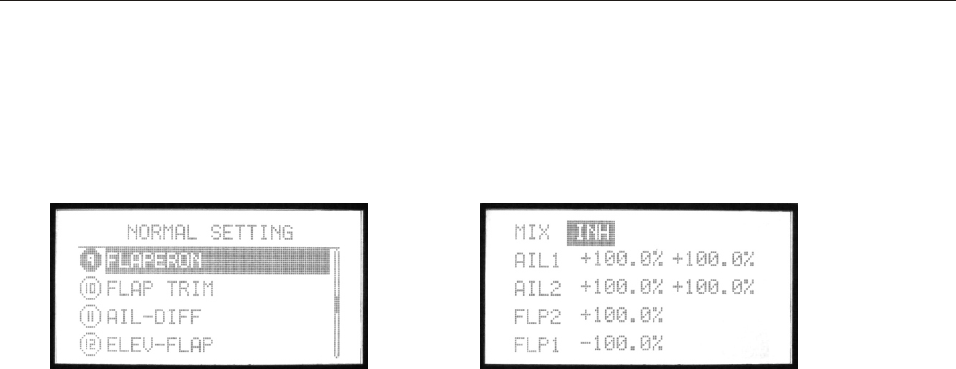
9. FLAPERON
FLAPERON mixing function uses on servo on each of the two
ailerons, and uses them for both aileron and flap function.
Setting Method:
Use up/down button to select FLAPERON, OK button
is to enter editing.
Steps:
1. Use direction buttons to select editing part.
2. Use +/- button to set value. Press OK button for seconds can
back default.
3. Press EXIT after setting.
INSTRUCTION
GLIDER
140
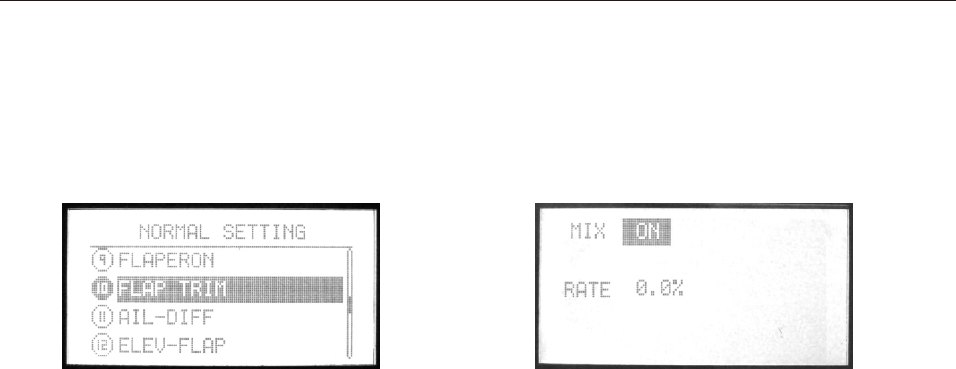
10. FLAP TRIM
FLAP TRIM assigns the primary flaperon control to allow
trimming in flight of the flap action of flaperons.
Setting Method:
Use up/down button to select FLAP TRIM, OK button
is to enter editing.
Steps:
1. Use direction buttons to select editing part.
2. Use +/- button to set value. Press OK button for seconds can
back default.
3. Press EXIT after setting.
INSTRUCTION
GLIDER
141
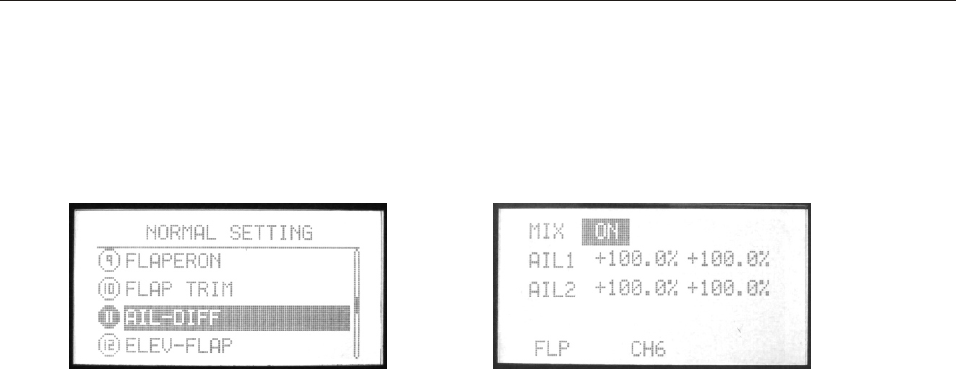
11. AIL-DIFF
Aileron differential(AIL-DIFF) is primarily used on 3-servo
wings, with one servo operating inboard flap(s) on Ch6, and
AIL-DIFF controlling proper aileron operation of 2 aileron
servos, plugged into Ch1 and Ch7.
Setting Method:
Use up/down button to select AIL-DIFF, OK button
is to enter editing.
Steps:
1. Use direction buttons to select editing part.
2. Use +/- button to set value. Press OK button for seconds can
back default.
3. Press EXIT after setting.
INSTRUCTION
GLIDER
142
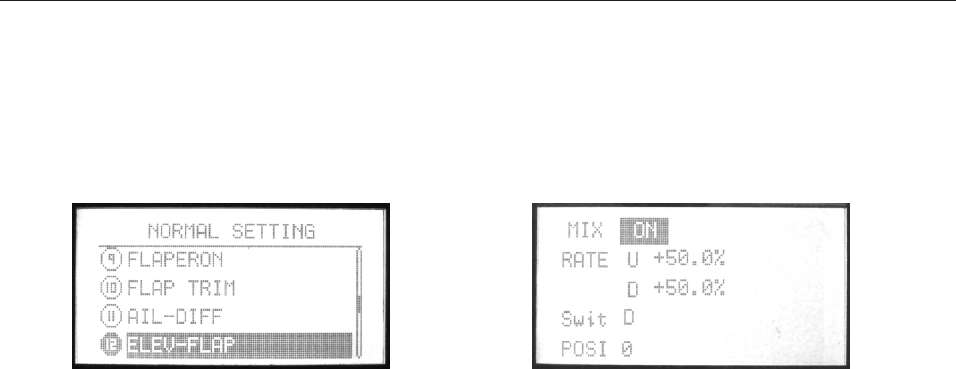
12. ELEV-FLAP
ELEV-FLAP mixing is the first pre-programmed mix we’ll cover.
This mix makes the flaps drop or rise whenever the elevator
stick is moved. It is most commonly used to make tighter pylon
turns or squarer corners in maneuvers. In most cases, the flaps
droop (are lowered) when up elevator is commanded.
Setting Method:
Use up/down button to select ELEV-FLAP, OK button
is to enter editing.
Steps:
1. Use direction buttons to select editing part.
2. Use +/- button to set value. Press OK button for seconds can
back default.
3. Press EXIT after setting.
INSTRUCTION
GLIDER
143
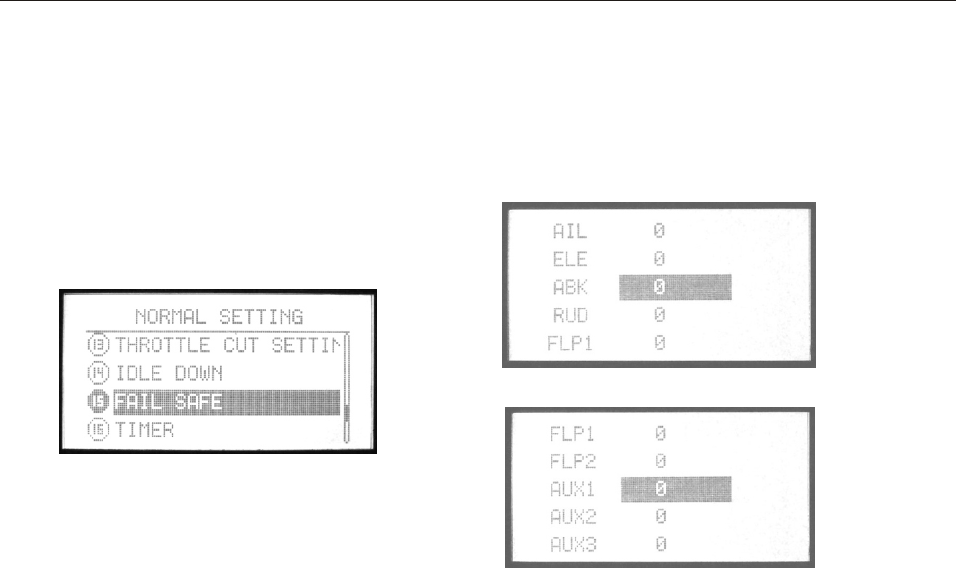
This function is to set responses in case of loss of signal or low RX
battery.
Setting Method:
Use up/down button to select FAIL SAFE, OK button is to enter
editing.
Steps:
1. Use direction buttons to select editing part.
2. Use +/- button to select “hold” or “0.0%”
3. Press OK button to confirm the current parameter.
4. Press EXIT after setting.
13. FAIL SAFE
INSTRUCTION
GLIDER
144
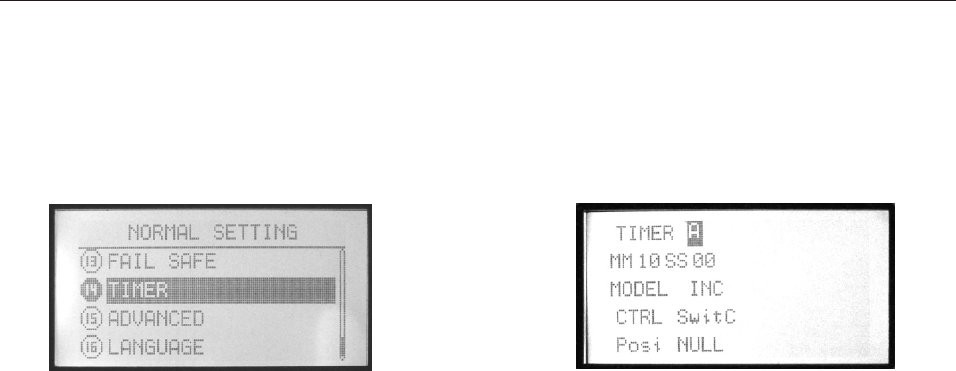
14. TIMER
The flight time of every helicopter is different according to
the different tank of fuel, engine, ESC, etc. Timer function
can alarm you to land before the fuel lacks.
The transmitter can set 3 timers (A, B, C). The longest time
can be set as MM99SS59. The countdown timer can alarm
user before 10 minutes. The alarm will become 2S/1S from
1S/1S in the last 10 seconds. When the countdown timer is
0, the time will add up.
The timer can be seen in the opening screen. Any switch
can be set to control the begin and stop of the time.
Setting Method:
Use up/down button to select TIMER, OK button is to enter
editing.
Steps:
1. Use direction buttons to select editing part.
2. Set timer. WFT09S can set 3 timers (A, B, C).
3. Use +/- button to set MM..SS... Press OK button for seconds
can back to default.
4. Use +/- button to set model.
5. Use +/- button to set control(CTRL).
6. Use +/- button to set the position which can active this
function.
7. Press EXIT after setting.
INSTRUCTION
GLIDER
145
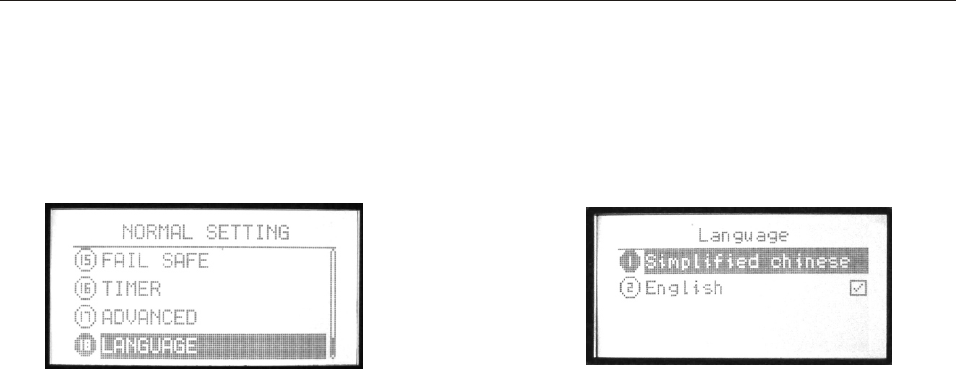
15. Language
This function is to select the language. There are 5 language selectable.
For example, the selection is as shown in the picture.
INSTRUCTION
GLIDER
146
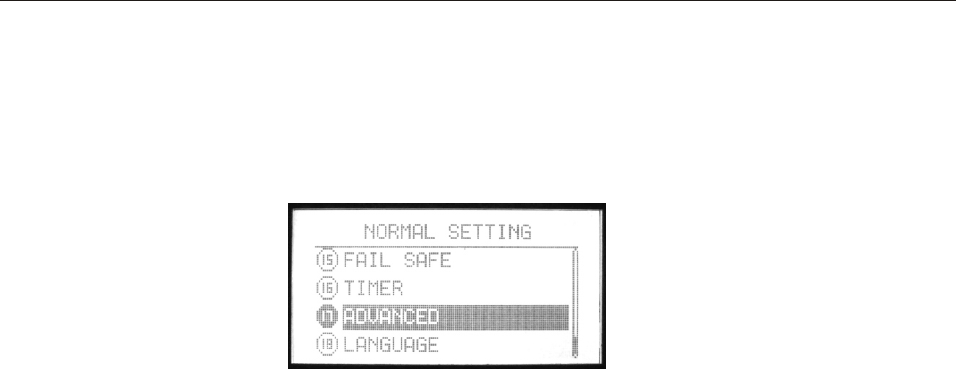
16. ADVANCED
To realize an idea fly, there are 20 advanced function in
ADVANCED.
Setting Method:
Use up/down button to select ADVANCED, OK button is to enter
editing. +/- button can turn page.
About each advanced functions please read the following pages.
INSTRUCTION
GLIDER
147
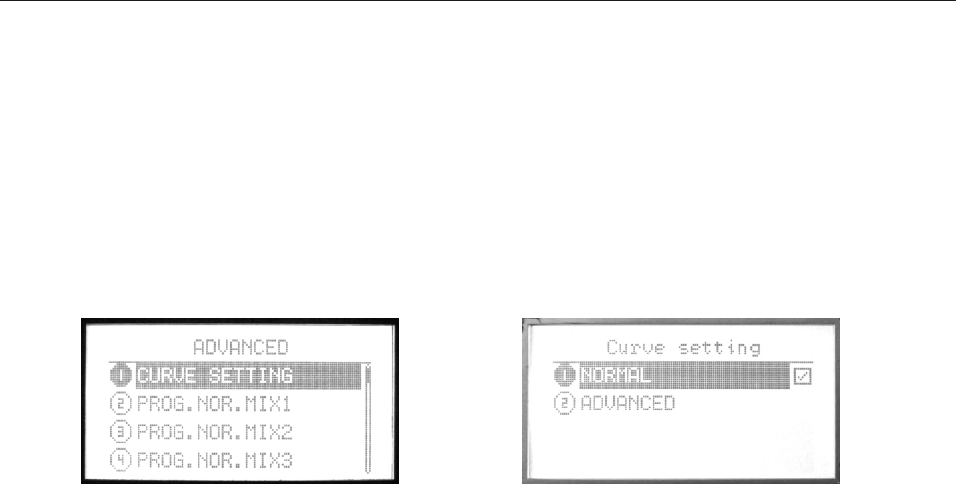
ADVANCED function introduction
(1). CURVE SETTING
There are 2 kinds of setting, Normal and Advanced.
Please refer to page 27.
INSTRUCTION
GLIDER
148
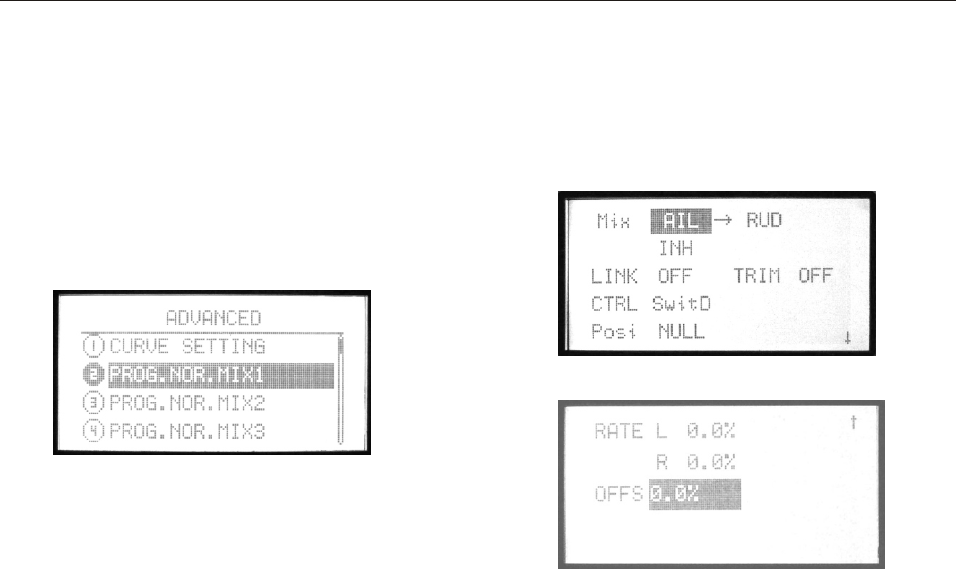
(2)-(8). PROG. NOR. MIX1-7
The mix program is to adjust the flying pose. There are 7series
programs with the same setting method. You can set one mix
and one mix with another one mix.
Setting Method
Use up/down button to select PROG. NOR. MIX, OK button is
to enter editing.
Steps:
1. Use direction buttons to select editing part. Set any two
channels mix.
2. Use +/- button to active or inhibit “Mix”.
3. Use +/- button to active or inhibit “Link” and “TRIM”.
4. Use +/- button to active or inhibit “CTRL“.
5. Use +/- button to set the control switch position.
6. Press EXIT after setting.
INSTRUCTION
GLIDER
149
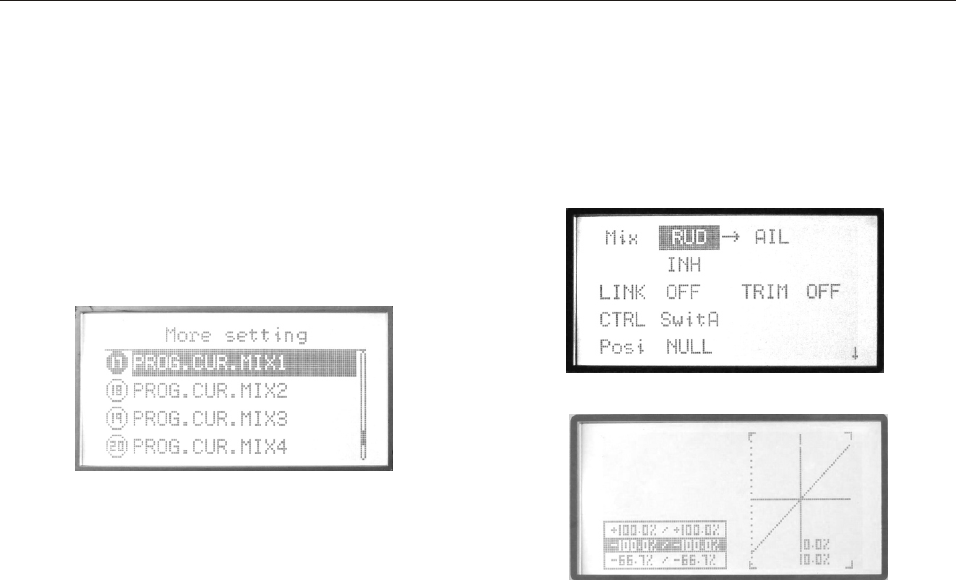
(9)-(12). PROG. CUR. MIX1-4
There are 4 curve mix program, the curve is made up by
2 to 10 point.
Setting Method:
Use up/down button to select PROG. CUR. MIX, OK button
is to enter editing.
Steps:
1. Use direction buttons to select editing part. Set any two
channels mix.
2. Use +/- button to active or inhibit “Mix”.
3. Use +/- button to active or inhibit “Link” and “TRIM”.
4. Use +/- button to active or inhibit “CTRL“.
5. Use +/- button to set the control switch position.
6. Set the curve point.(Normal/Advanced). Please refer to
page 27.
7. Press EXIT after setting.
INSTRUCTION
GLIDER
150

(13). BUTTERFLY
AIR BRAKE simultaneously moves the flaps, twin ailerons
and elevators, and is usually used to make steep descents or
to limit increases in airspeed in dives.
Setting Method:
Use up/down button to select AIR BRAKE, OK button
is to enter editing.
Steps:
1. Use direction buttons to select editing part.
2. Use +/- button to active or inhibit “Mix”.
3. Use +/- button to set Swit, POSI. Press OK button for seconds
can back default.
4. Use +/- button to set CTRL (MAN/ THR).
5. Use +/- button to set delay value. Press OK button for seconds
can back default.
6. Press EXIT after setting.
INSTRUCTION
GLIDER
151
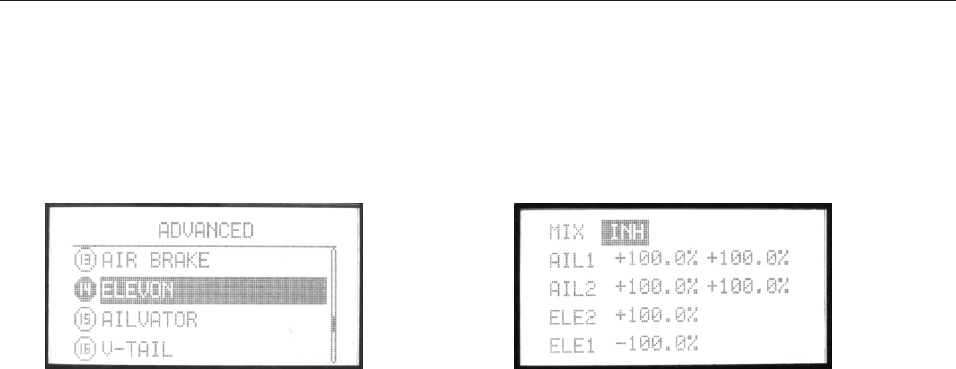
(14). ELEVON
This function used with delta wings, flying wings, and other
tailless aircraft that combine aileron and elevator functions,
using two servos, one on each elevon. The aileron/elevator
responses of each servo can be adjusted independently.
Setting Method:
Use up/down button to select ELEVON, OK button is to
enter editing.
Steps:
1. Use direction buttons to select editing part.
2. Use +/- button to set value. Press OK button for seconds can
back default.
3. Press EXIT after setting.
INSTRUCTION
GLIDER
152
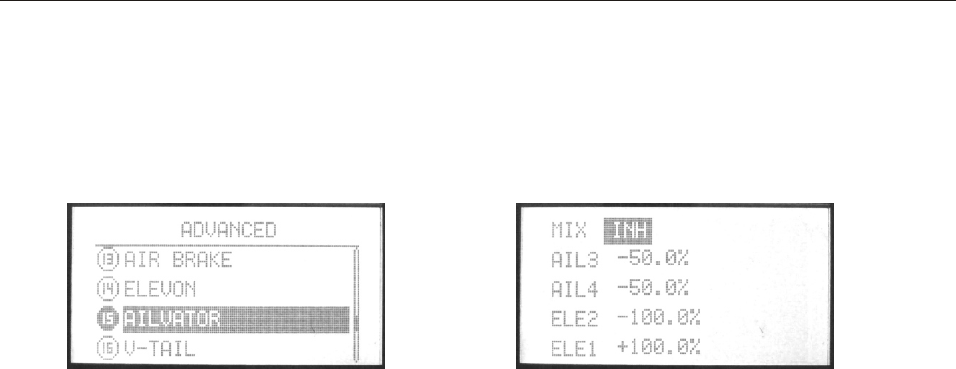
(15). AILVATOR
AILEVATOR mixing function uses one servo on each of the
two elevators, and combines the elevator function with the
aileron function(unless aileron travel is set to 0).
Setting Method:
Use up/down button to select AILVATOR, OK button is to
enter editing.
Steps:
1. Use direction buttons to select editing part.
2. Use +/- button to set value. Press OK button for seconds can
back default.
3. Press EXIT after setting.
INSTRUCTION
GLIDER
153
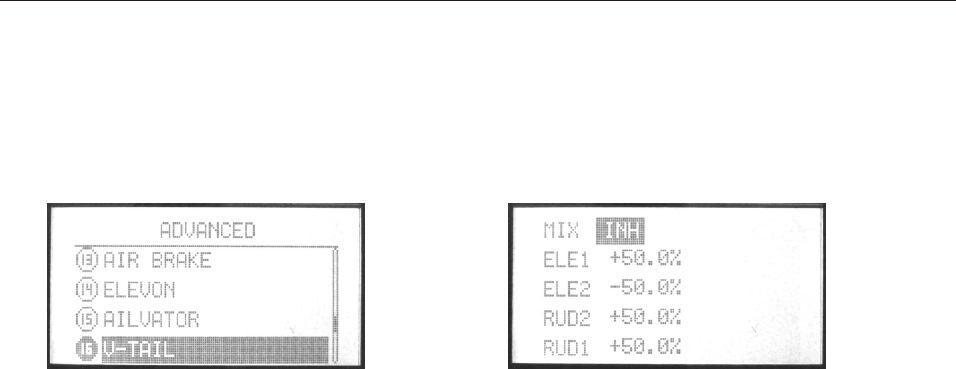
(16). V-TAIL
V-TAIL mixing is used with v-tail aircraft so that both elevator
and rudder functions are combined for the two tail surfaces.
Both elevator and rudder travel can be adjusted independently
on each surface.
Setting Method:
Use up/down button to select V-TAIL, OK button is to
enter editing.
Steps:
1. Use direction buttons to select editing part.
2. Use +/- button to set value. Press OK button for seconds can
back default.
3. Press EXIT after setting.
INSTRUCTION
GLIDER
154
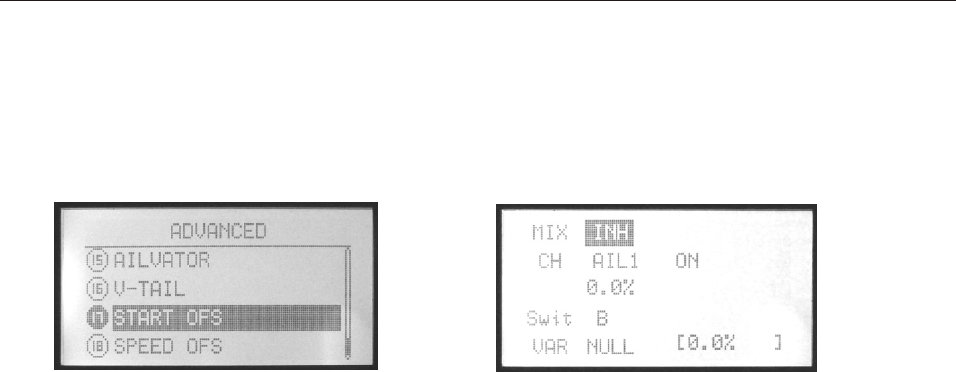
(17). START OFS
This function is used to offset the aileron, elevator, and flap servos
to the position that provides maximum lift during launch. Normally
the ailerons and flaps are drooped about 20-30, with the flaps drooped
slightly more to prevent tip-stailing on tow. The elevator can also be
offset in oo trim out any pitch changes caused by the flap and aileron
presets.
Setting Method:
Use up/down button to select START OFS, OK button is to
enter editing.
Steps:
1. Use direction buttons to select editing part.
2. Use +/- button to set value. Press OK button for seconds can
back default.
3. Press EXIT after setting.
INSTRUCTION
GLIDER
155
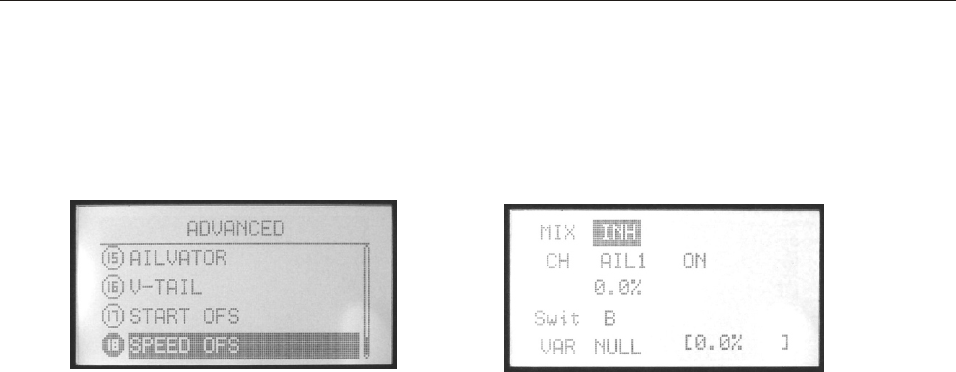
(18). SPEED OFS
(19). Code matching
This function is used to offset the aileron, elevator, and flap servos
for minimum drag in cruise and high-speed flight. Normally the
ailerons and flaps are raised about 3-5.
Setting Method:
Use up/down button to select SPEED OFS, OK button is to enter
editing.
Steps:
1. Use direction buttons to select editing part.
2. Use +/- button to active or inhibit this function. Press OK
button for seconds can back default.
3. Press EXIT after setting.
INSTRUCTION
GLIDER
Please refer to page 16.
156

TO THE PILOT
Is the 2.4G version which includes helicopter, airplane and glider
function. Thank you for using the radio systems.
We welcome your valuable advice and we will continue developing the radio.
INSTRUCTION
Welcome to contact us!
Www.wflysz.com
sales@wflysz.com
Tel: 0086 755 26581817
Fax: 0086 755 26581821
157
FCC WARNING
This device complies with Part 15 of the FCC Rules. Operation is subject to the following two
conditions:
(1) this device may not cause harmful interference, and
(2) this device must accept any interference received, including interference that may cause
undesired operation.
NOTE 1: The manufacturer is not responsible for any changes or modifications not expressly
approved by the manufacturer for compliance, such modifications could void the user’s authority
to operate the equipment.